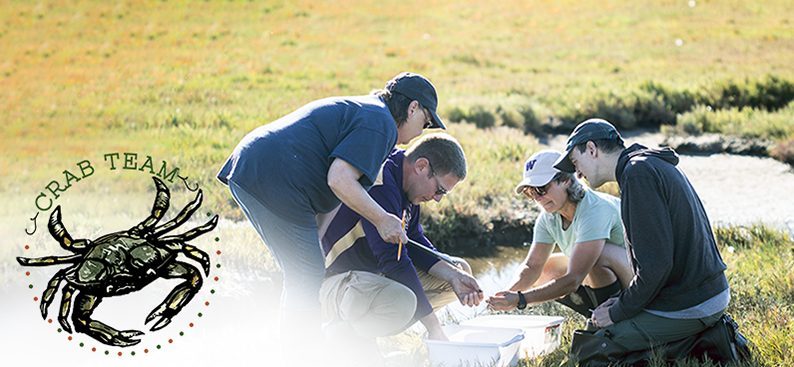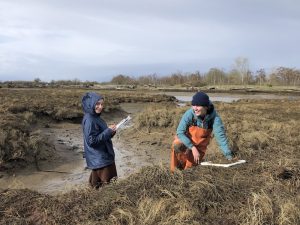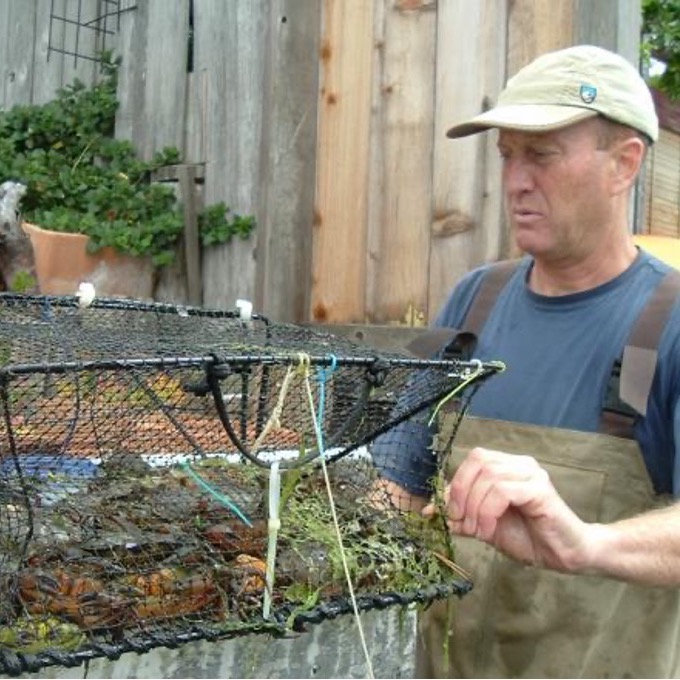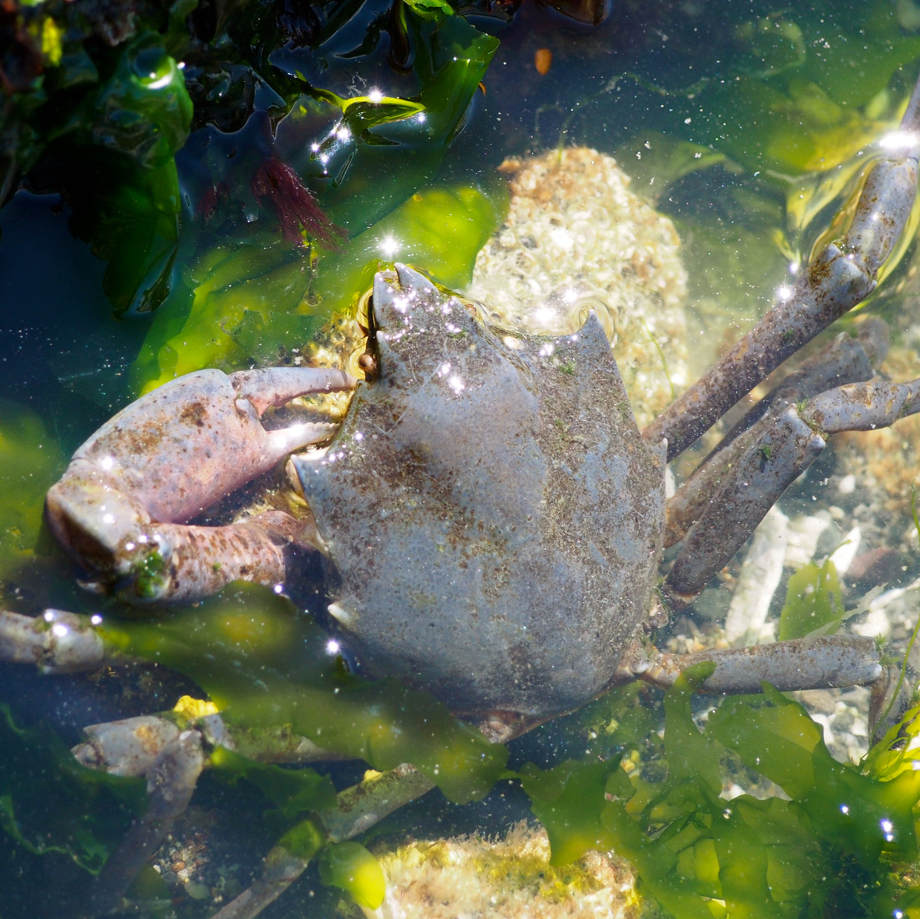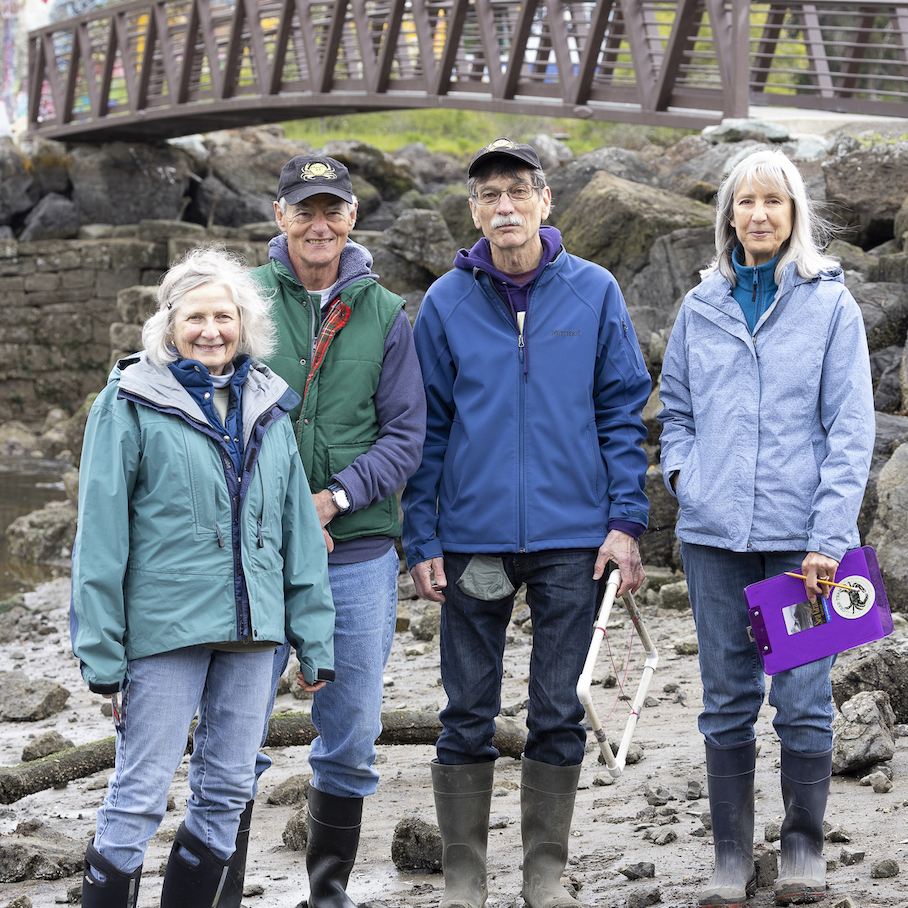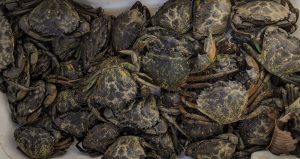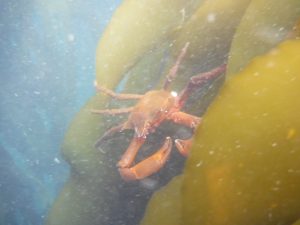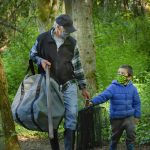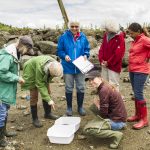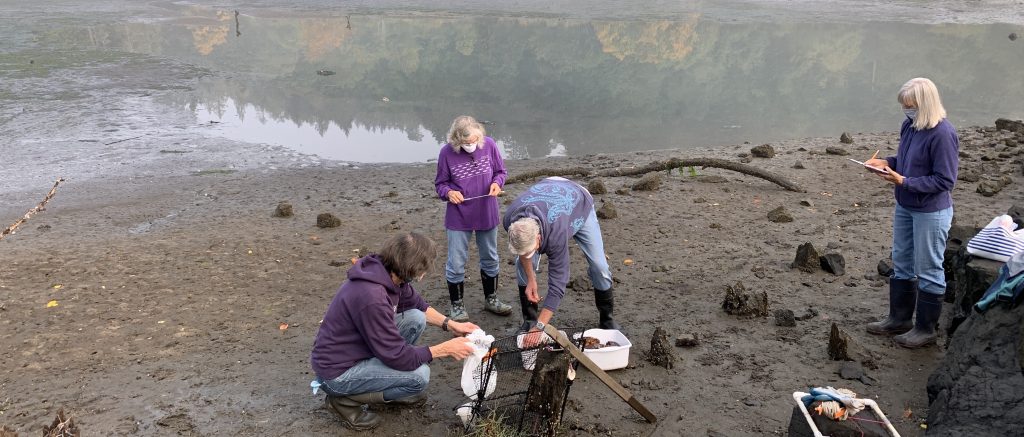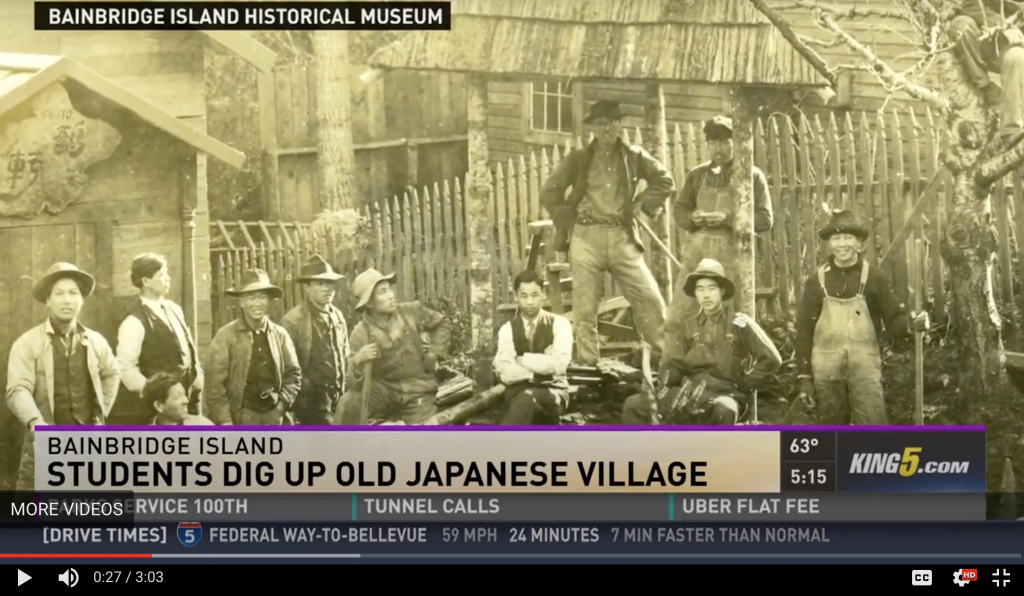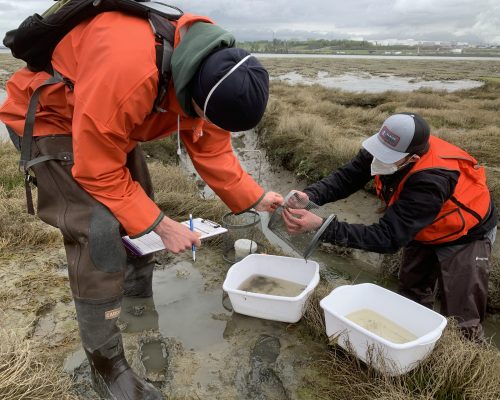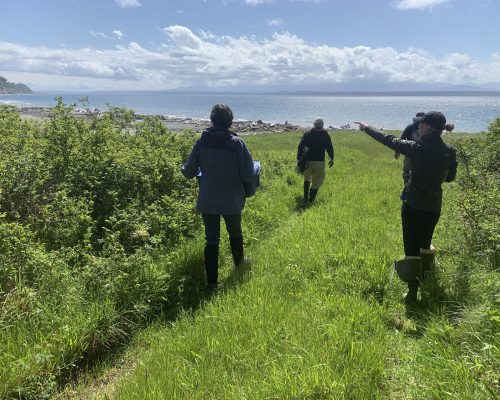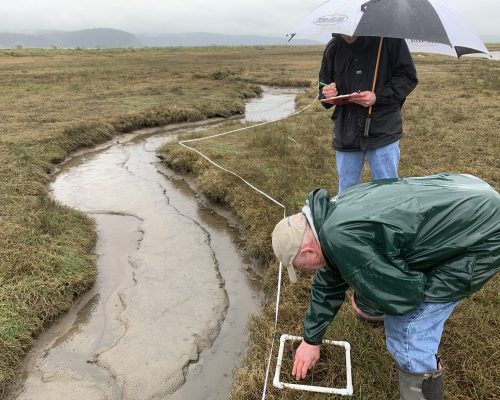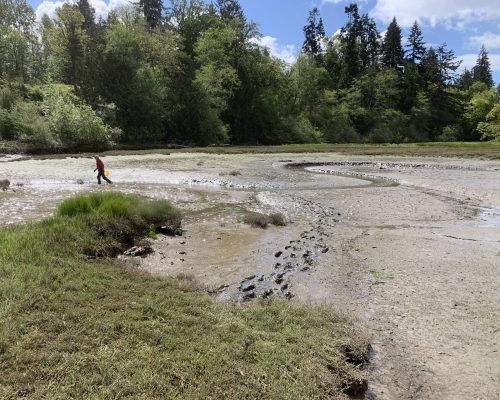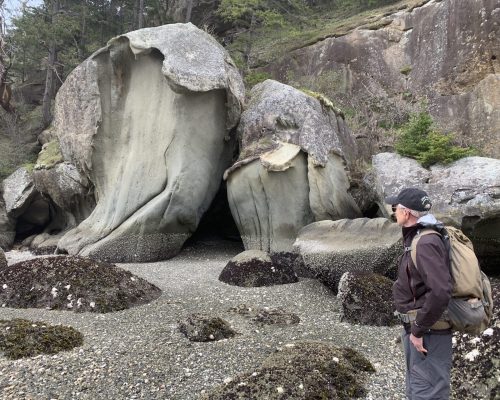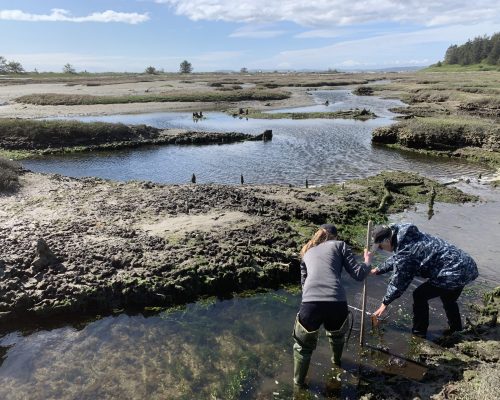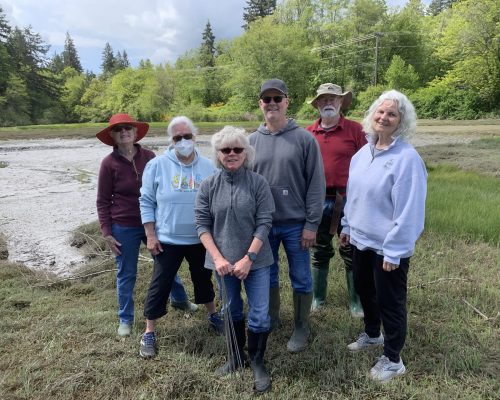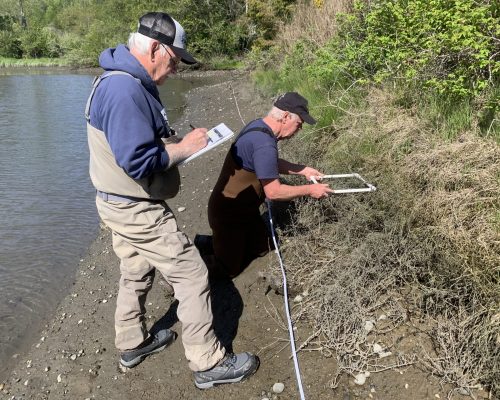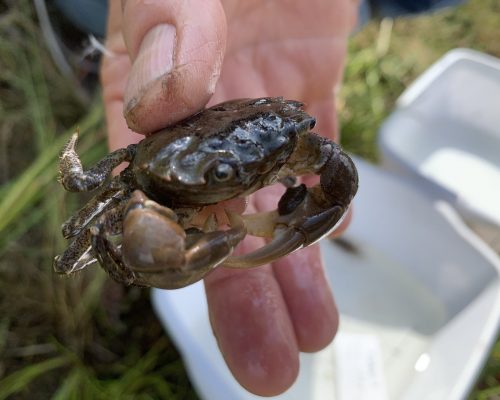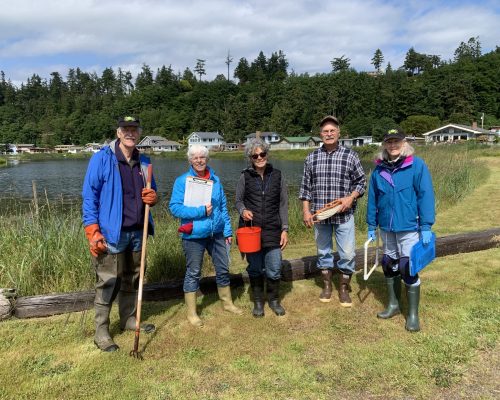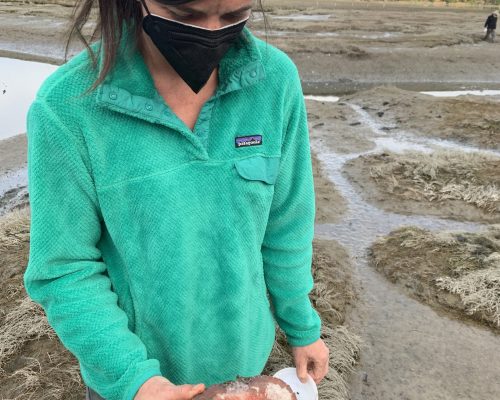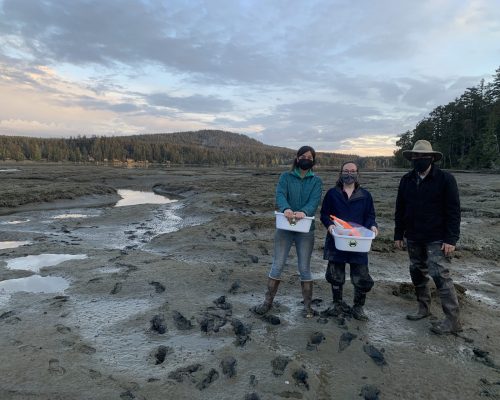A Green Crab Emergency
August 17, 2022
As the long radio silence might imply, things have been busy since our last newsletter in the fall of 2021. Last winter, several emergency declarations related to green crab, including Lummi Nation, Shoalwater Bay Indian Tribe, and the State of Washington, dramatically increased the visibility and urgency of management across the state. The past year has seen an unparalleled increase in the scale of effort to manage green crab across a growing list of partners. The resources associated with these changes offer an extraordinarily rare and precious opportunity to mount a substantial response to a globally damaging invasive species relatively early in the invasion process.
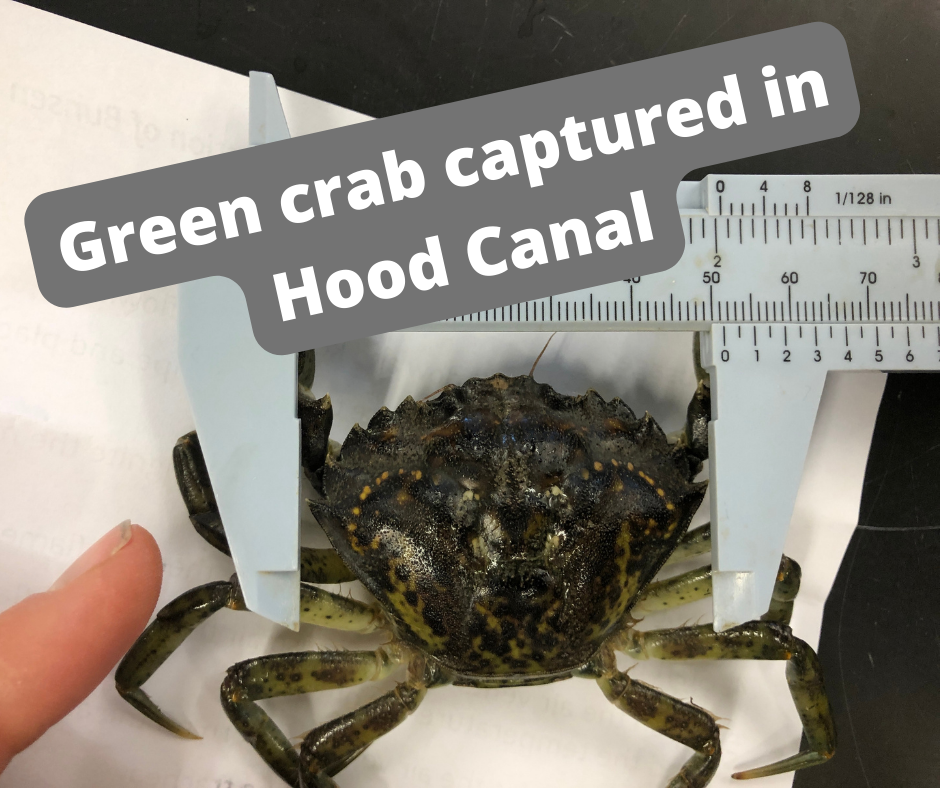
WSG Crab Team staff have been playing an important role in this growth, conducting research that informs management, and providing scientific advice and training to build capacity across the growing network of management partners. But more than ever, the Crab Team monitoring network, now in our eighth (!!!) year continues to be a critical piece of the puzzle. Several recent detections, including the first ever in Hood Canal and first at the Crab Team site in Chuckanut Bay, were only possible because of the work of Crab Team volunteers. The information these detections yield helps fulfill the promise of the network that more than 200 volunteers and partners have been building on since 2015. While the inland early detection network is more or less complete at around 57 sites, it’s been joined by 10 “sentinel” sites on the coast that offer insight into coastal and inland patterns and differences.
To be successful, the effort needs as much energy and inspiration as we can collectively muster. And as more resources are brought to bear on green crab, you can also stay up to date on the actions of our colleagues at the Washington Department of Fish and Wildlife, and other partners around the state through WDFW’s emergency reports and by signing up for management update emails from WDFW. Crab Team is also working to find new ways to leverage the interest and enthusiasm of the public (stay tuned). Meanwhile, Crab Team volunteers and staff will keep our eyes on the beach and our boots in the mud!
All our pinchy best,
Crab Team HQ
What is the Hydra Effect: Could Trapping Green Crabs Increase Their Numbers?
Unwelcome and Tough to Evict, When “Eradicated” Species Bounce Back With a Vengeance, and Green Crab Study: Scientists Learn ‘Eradication’ May Not Achieve Desired Solution… These were just a few of the provocative headlines that appeared last year following publication of a study by Dr. Ted Grosholz and colleagues in the Proceedings of the National Academy of Sciences. And while the study in question focused on invasive European green crab in California, Washingtonians were rightly alarmed by these headlines streaming across their newsfeeds. After all, Washington State is experiencing its own burgeoning green crab invasion (see What Does the Invasion at Lummi Mean for the Salish Sea? and Coastal Green Crab Captures Increased in 2021 on the Crab Team blog).
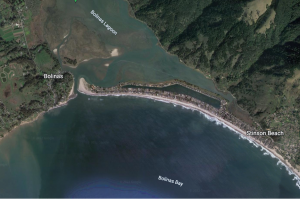
Seadrift Lagoon is a manmade seawater pond sandwiched between Bolinas Lagoon and Bolinas Bay. A little over a mile in length and 500 feet across at its widest point, the lagoon was built in the 1950s to support a gated vacation community. Green crab arrived in Seadrift lagoon in the early 1990s and quickly became abundant. (Click to Enlarge)
The paper, Stage-specific overcompensation, the hydra effect, and the failure to eradicate an invasive predator, describes a case study in Stinson Beach, California, involving attempts to eradicate the prolific invasive crab from Seadrift Lagoon, a 40 acre manmade seawater pond sandwiched between Bolinas Lagoon and Bolinas Bay. Beginning in 2009, Grosholz and colleagues trapped Seadrift Lagoon extensively and repeatedly in an effort to extirpate the crabs. By 2013, the researchers estimated the population had declined from more than 125,000 to fewer than 10,000 crabs. However, by just the next year, the population had rebounded to more than 300,000 young crabs – nearly three times the pre-eradication population size. Because similar population booms weren’t observed in nearby embayments, the researchers concluded that their own management efforts were to blame for the increase. But why?
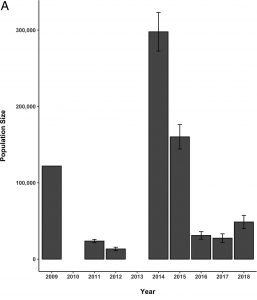
Figure 1A reproduced from Grosholz et al. 2021 showing the estimated population size of green crabs within Seadrift Lagoon from 2009-2018, as partial evidence of overcompensation occurring with the dramatic increase in 2014. Note that population estimates were not available for 2010 or 2013.
The response of green crab populations in this situation has been attributed to what’s called “the hydra effect” (note: scientists get a bad rap for being boring, but we do have a knack for naming things). The hydra effect (Thanks, Abrams and Matsuda!) occurs when a species increases in number despite a higher death rate. This counter-intuitive result is named for the Greek legend of the Lernaean Hydra, a monster known for growing two heads for each one a would-be hero might cut off. Hydra effects can occur for a variety of reasons but most commonly because a population is released from competition or predation. In Seadrift Lagoon, there are nearly no other species present capable of preying on green crabs. Therefore, large adult green crabs are the most abundant predator and competitor of other green crabs. Because of this dynamic, the eradication effort had the unintended consequence of decreasing cannibalism and competition within the species. Without many large, hungry green crabs gobbling up little green crabs, the new generation of little crabs survived better and “overcompensated” for the loss of the older generation. Obviously, this was not what Grosholz and colleagues had anticipated.
Making Sense of Overcompensation
The case of Seadrift Lagoon led to a lot of scientific soul-searching by the study authors and possibly the most provocative headline of them all… Are We Managing Invasive Species Wrong? This loaded question has had many folks involved with green crab wringing their hands. Before we chalk up the situation to the mythological power of the hydra or simply throw in the towel on controlling green crab altogether, there are a couple of important points to consider, particularly when drawing lessons to apply to Washington State and elsewhere – first, compensatory processes that contribute to the hydra effect aren’t the boogeyman, and second, context matters.
While overcompensation of the green crab population in Seadrift Lagoon was a surprise, it isn’t without precedent. Overcompensation has been observed in animals ranging from mosquitos to voles and smallmouth bass to Soay sheep. Moreover, compensatory processes in general are well-studied and important features of sustainable management of fished or hunted species. An underlying principle of sustainable management is that reproduction and survival are dependent on the size of a population. There are also limits on the size of a population based on available resources. Put simply, harvest (removal) is thought to pressure on and competition for limited resources, so that remaining individuals reproduce more and survive better than they would have if no harvest occurred. Bottom line: whether managers are trying to sustain or eradicate a population, understanding how compensatory processes operate is critical to success and achieving desired outcomes.
Will Washington Face a Hydra, Too?
Another point highlighted by the Seadrift Lagoon example – context matters. Unlike natural bays and estuaries along the Pacific coast that teem with predatory fish and crabs, Seadrift Lagoon is an isolated, artificial pond, where cannibalism and competition with other green crab likely have an outsized impact on dynamics of the green crab population. Added to this, limited exchange of water with the coastal ocean means that green crab larvae hatched within Seadrift Lagoon are likely retained and settle there. In this way, the lagoon is very close to a very large isolated experimental fish tank. In this unique situation, removing adult green crabs as part of the eradication effort had the unintended consequence of making life easier for their progeny. While this is certainly an interesting ecological phenomenon, we wouldn’t necessarily expect it to occur in other areas with more abundant and diverse native predators and competitors. We also wouldn’t expect it to occur (at least not so dramatically) if many or most of the larvae were expelled from the lagoon and dispersed more broadly along the coast. In fact, it may be reassuring that, here in Washington, in most locations where we have been working for several years to reduce green crab populations through trapping, like Dungeness Spit and Drayton Harbor, we have not encountered any evidence of overcompensation.
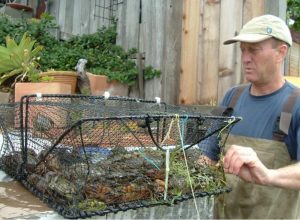
Ted Grosholz and colleagues tried to eliminate invasive green crab from Seadrift Lagoon, near Stinson Beach, California. Their study, published in the Proceedings of the National Academies of Science, describes how these efforts failed because of overcompensation of the population. Copyright UC Davis
What Do We Learn from Seadrift?
So, perhaps, the most important lesson of the study by Grosholz and colleagues is the need for careful development of management plans that specifically consider green crab biology, ecosystem properties, and oceanographic processes. As study co-author and marine biologist with the Smithsonian Environmental Research Center, Greg Ruiz said, “instead of a one-size-fits-all approach, this study highlights the need to evaluate possible unintended consequences in selecting management strategies and tailoring these to the particular context and expected outcome.” Important factors, like native predator abundance and larval retention, which can set the stage for overcompensation, vary across Washington’s shorelines, and already we can see signs that these might be influencing whether or how quickly populations are growing at different sites. This likely means it will be necessary to develop separate management plans for Washington’s coast and inland waters, carefully honing the objectives of any management action based on characteristics of individual sites and water bodies. Management might even include consideration of alternative approaches, such as functional eradication, in places where green crabs cannot be completely eliminated. Moreover, special cases like the Lummi Sea Pond, which more closely resemble conditions in Seadrift Lagoon, might require a tailored approach with strategies and goals that are not as well suited to other locations. Far from being the catastrophe of mythological proportions portended by the hydra, the case study from Seadrift provides valuable insight into an edge case, understanding of which, though it may not be widespread, will undoubtedly enhance efforts to manage green crab in Washington waters and elsewhere.
-P. Sean McDonald
*While we try to link you directly to the research we reference, some of the studies cited in this article are not open access. If you have any questions about any of the works cited here, please feel free to reach out to crabteam@uw.edu.
Trapped at Home: Crab Team’s Spider Crabs
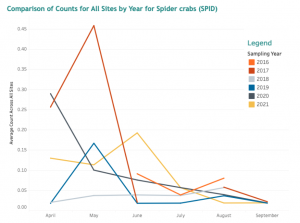
Figure 1: Spider crab counts across all sites and by year for each month. Explore more data at Crab Team’s Tableau site. Click to enlarge.
While Majoids aren’t a major player in Crab Team trapping, this colorful crab clan rocks both style and personality. Of the spider crab species, we’re pretty sure that the Northern kelp crab (Pugettia producta) is the only species that has shown up in Crab Team traps so far, irregularly and only at a handful of impoundment-/lagoon-type sites. Interestingly, it’s mostly during the early part of the season when spider crabs show up in traps, then there seem to be fewer later in the season (Figure 1). Crab Team members may still find a molt or washed up carcass of one of the handful of other spider crab species in our region, and heck, let’s explore this group for a bit so we can all have fun keeping an eye out for them as we explore the beach or swim, snorkel or dive the Salish Sea.
Spider crabs (SPID in Crab Team lingo) are all in the superfamily Majoidea and are one of a few groups of species that Crab Team lumps into a taxonomic pot rather than always identifying down to species. They can be tricky under the best of conditions, but then they go and glom other plants and animals onto themselves, sometimes making diagnostic characteristics tough to see. So, like flat fish (FLAT) and eel-like fishes (ELFS), we figured it’s in the interest of accuracy and sanity to not try to “overidentify” spider crabs. That said, Crab Team members, staff and colleagues have enjoyed looking at many a picture of animals from those groups to see if we can confidently add species identifications to the footnotes.
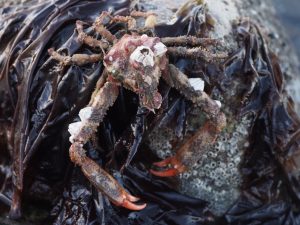
Male sharpnose crab (Scyra acutifrons), with its aging terminal molt and ridiculously impressively large/long claws Photo: Wendy Feltham
For starters, spider crabs do look spidery. They tend to have long and spindly walking legs and claws that are reminiscent of the spiders who defend the corners and crannies of our homes from all manner of bugs. [Note: While decapods have spider crabs, arachnids have crab spiders… I just find that funny.] Along with their skinny legs, their carapace is a different shape than most of our other crabs, being narrower than it is long for most species and having more of a shield or pear-shaped appearance. In fact, the outline of their carapace – the points, the curves, the rostrum – is often enough to identify one species from another… that is if you can see the carapace through the menagerie they are growing on themselves. If the carapace is difficult to see, often the colors and patterns of claws can help in identifying species. Speaking of claws, spider crabs are certainly notable in that their final molt also aligns with sexual maturity, and while that means females invest their energy into egg making, the males invest in CLAW SUPERSIZING, often resulting in seemingly ridiculously large, long claws.
Majoids are pretty diverse in the eastern Pacific. On Washington’s shoreline and shallow subtidal areas, we could probably find a handful of species. In Greg Jensen’s Crabs and Shrimps of the Pacific Coast, ten species from two families (listed below) are described as being in Washington waters. We’ll focus on one from each family that tide poolers, beach explorers and Crab Teamers are probably most likely to come across.
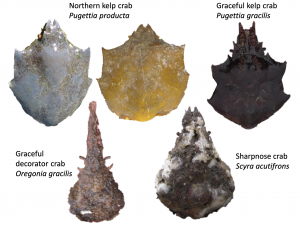
Comparison of four relatively common Washington nearshore spider crab species’ carapaces. Photos: Wendy Feltham and Jeff Adams.
Washington spider crabs (* = more detail below)
Family: Oregoniidae
- *Graceful decorator crab (Oregonia gracilis – up to 39mm)
- Pacific lyre crab (Hyas lyratus – males to 80mm, females to 55mm)
Often with graceful decorator; with much shorter rostrum - Southern Tanner/snow crab (Chionoecetes bairdi – males to >200mm)
(yes, tasty snow crab!) On open mud/sand; rarely shallow
Family: Epialtidae
- *Northern kelp crab (Pugettia producta – males to 110mm, females to 90 mm)
- Graceful kelp crab (Pugettia gracilis – to 45mm)
Common among rocks, algae and eelgrass - Sharpnose crab (Scyra acutifrons – to 45mm)
On rocks or other structure and fast currents; more with inverts than algae - Longhorn decorator crab (Chorilia longipes – to 45mm)
Usually in deeper (>30’) water - Cryptic kelp crab (Pugettia richii – males to 42mm, females to 33mm)
Mostly Pacific coast in kelp forests - Foliate kelp crab (Pugettia foliata – males to 42mm, females to 33mm
Mostly Pacific coast in kelp or rocks - Moss crab (Loxorhynchus crispatus – males to 123mm, females to 79mm)
More likely on Pacific coast and south of Washington
Graceful decorator crab
The graceful decorator crab (Oregonia gracilis), Oregoniidae’s master of disguise, is the most commonly encountered member of the family along Washington shorelines. Spider crabs run the gamut of decoration, and, using little curved hairs on their bodies, most will do a bit of decorating, even if it’s just a piece of algae on their nose when young (because why not?!). The graceful decorator has loads of these hairs that they can use to stash all manner of plant and animal material. Thorough decoration is especially common in young and female decorators who have abundant hairs to use for attachment. Older males generally have fewer hairs and may be more minimalistic in their ornamentation.
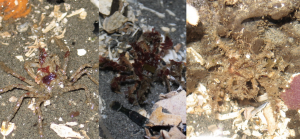
Now, for ID, just look for the spine next to the eye… Juvenile graceful decorators can be easily overlooked and hard to be sure of identification because of their thorough decoration. Photos: Jeff Adams (Click to enlarge)
Assuming you can see enough of their body at all through their bio-camo… You can look for their long rostral horns that stick out parallel from their head. Also very helpful is a long, thin, prominent spine behind each long eye stalk. Otherwise, their body shape pretty much looks like a pear with eyes. When you can see through to their color, they tend not to be very bright, and while they have small hairs, they also don’t have a lot of spikes on their carapace.
Researchers at the UW and Miami University ran experiments with graceful decorators to see how they used decorating materials in different life stages (Hein and Jacobs, 2016). They found that decoration started after megalope morphed into juveniles. It’s fun to imagine these super tiny crabs (3mm long!) already sticking things to itty bitty carapaces and legs. Interestingly, the researchers found that juveniles used mostly free floating organic debris to decorate, while it’s not until they mature further that their decorations focus more on algae and other animals. Juveniles molt so frequently, that it seems sensible to not invest too much into your personal zoo and botanical garden. As they use more flora and fauna to decorate, they will often transfer their pets from their molted shell to their new, hardening body before fully abandoning their molt.
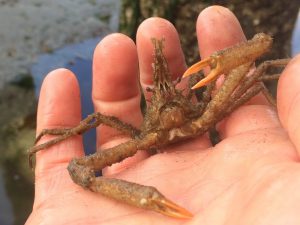
Male graceful decorator crab with mature claws and without much decoration. Larger males tend to have fewer of the hairs to which to attach things. Also note the narrow spine below each eyestalk that is helpful for identifying the species. Photo: Jeff Adams (Click to enlarge)
Northern kelp crab
And let’s wrap up with the crab that we do see in Crab Team traps. The northern kelp crab (Pugettia producta) is a big, aggressive, omnivorous, abundant beastie that will shred everything from its favorite bull or giant kelp to snails, seagrass seeds, sea slugs, jellyfish and occasionally a passing diver. Interestingly, along with helmet crabs and hairy shore crabs, this species frequently fools beachgoers into thinking it might be a European green crab.
Maybe it’s the color? While the shape is quite different from a green crab, Northern kelp crabs are striking for their often bright olive coloring, and, especially when more mature, their bright red undersides. Their frequently undecorated carapace is relatively smooth and very shield-like with just a couple prominent spines and short, rounded rostral horns. Another species, the graceful kelp crab (Pugettia gracilis) is also pretty common and looks very similar to the northern kelp crab. The graceful’s rostral spines are a bit longer and carapace has an extra spine and more prominent indentation in the middle. Perhaps most helpful if present are the claw tips, which are usually grayish or blue, tipped with orange in graceful and more reddish or olive in northern.
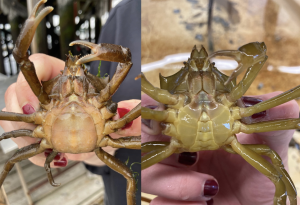
Female and male northern kelp crab abdomens (and ready to pinch claws!). Photos: Katie Dobkowski (Click to enlarge)
Adults can be very abundant in kelp canopies. That’s garnered them more recent attention, particularly in the Salish Sea, as bull kelp has recently declined or disappeared in many locations. A couple of studies out of the UW’s Friday Harbor Labs showed that northern kelp crabs can play a strong role in reducing the growth and survival of bull kelp (Dobkowski, 2017) and that Salish Sea northern kelp crabs have an affinity toward fresh bull kelp (Dobkowski et al, 2017). On the upside, when the invasive kelp Undaria showed up in California, researchers found that northern kelp crabs mowed down one of their study cohorts (a particularly abundant cohort), preventing the plants from reaching maturity (Thornber et al, 2004). When kelp is not abundant, and particularly during winter after algae largely senesces, northern kelp crabs are happy to scurry off and scavenge barnacles, anemones, other invertebrates … and maybe mackerel? The pattern of when we see them in Crab Team traps may reflect the seasonality of when they’re foraging broadly and when they’re hunting kelp.
So, keep your eyes on the beach (and face in the water if you’re so inclined) to enjoy this cool critter collection, and please share any interesting finds. In fact, one great place to do so is the Crabs of the World iNaturalist project, created by one of Crab Team’s very own super volunteers, Wendy Feltham.
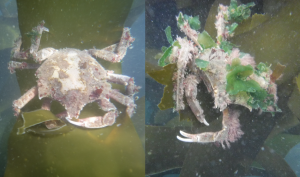
Nom, nom, nom… Surprisingly well dressed Northern kelp crabs feeding on bull kelp blades. Photos: Aina Lei Hori (Click to enlarge)
– Jeff Adams
If you’ve ever conducted a Crab Team shoreline survey, you’ve likely circled “mud” more than once when identifying the substrate type. At the Crab Team site at Blakely Harbor, however, a “sawdust” option may be more relevant, considering what lies beneath the mud in this harbor, a location rich with human history and industry.
Cultural and Industrial History of Blakely Harbor
Before the arrival of Europeans, the land that is now known as Blakely Harbor was traditionally a winter residence for the Suquamish people, who take their name from the traditional Lushootseed phrase for “people of the clear saltwater.” These expert fishermen, canoe builders and basket weavers have traditionally used canoes to travel to temporary camps in the spring, summer and early fall to fish, hunt and gather wild foods.
By the late 1800s, this harbor had changed dramatically with the influx of European settlers. In 1864, Nova Scotia sea captain Captain William Renton transformed the tranquil bay into a bustling sawmill, once touted as one of the world’s largest, highest-producing mills in that time period, turning out 200,000 board feet of lumber each day at its peak.

In the early 20th century, the lumber mill and shipyard at Blakely Harbor bustled with activity, a stark contrast to the quiet restoration site and park at the same location today. Photo courtesy of the Bainbridge Island Historical Museum.
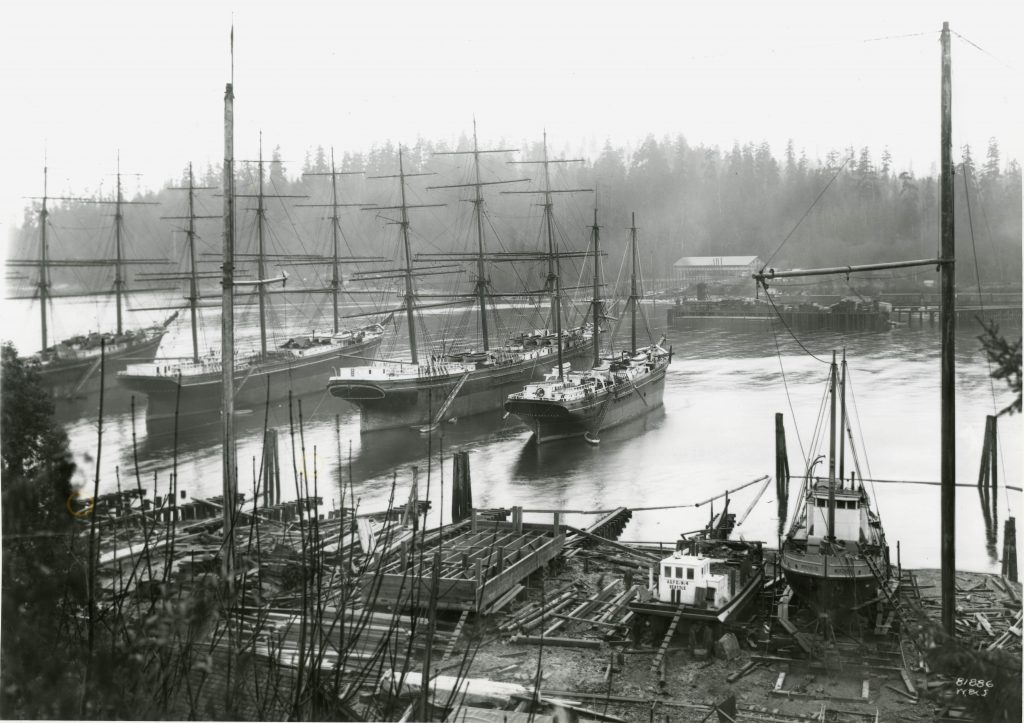
A large number of ships were required to carry lumber from Washington State to locations all over the world. To get the job done, all kinds of ships were utilized for transport, ranging from tugboats to steamers. Photo courtesy of the Bainbridge Island Historical Museum.
In 1880, a shipyard was moved from Port Ludlow, Washington to a site near the Port Blakely Lumber Mill to keep up with the shipping demand, carrying lumber to locations all over the world on a wide diversity of ships, ranging from steamers, tugs and even several yachts. By 1882, the mill began accessing timber from forests to the south of the harbor through a company-built railroad named the Blakely Line, which hauled logs from Mason County to the southern part of Puget Sound. At this point, the mill town was thriving. In 1895, a reporter from the Press-Times wrote that, “the noise of whirring wheels, the heavy pulsations of many engines and the incessant hum of the saws and the planers impress a person with the feeling that these are all a part of a gigantic living being and not mechanical devices that are controlled by human beings” (Price 2005 p. 125).
The Yama Community
The Port Blakely Mill Company employed mill workers from all over the world. Among the workers who worked at the mill were a large population of Japanese immigrants who eventually settled upland of the harbor in a 7-acre community named Yama, which means “mountain” or “hill” in Japanese. The community was home to as many as 200 residents, complete with a hotel, two churches, a tea room and even a photo studio. Despite Blakely Harbor’s remote location, historical accounts highlight the hand-made ice cream available in an ice cream parlor in Yama, where cream was sourced from a local dairy. By 1907, the mill had burned to the ground twice, was rebuilt, was sold to new owners and eventually closed after the First World War, in 1924 (Price 2005). Consequently, Yama was abandoned and the once thriving community slowly became overgrown with little evidence of it remaining.
In 2014, Olympic College professor Floyd Aranyosi teamed up with other Olympic College staff to lead anthropology students in what they named the “Yama Project,” a project aimed at learning more about the people who inhabited this historic site. Likely due to the steep topography underlying the community, much of this settlement remained relatively undisturbed, offering unique insights into the daily life of these mill-era residents.
A Story of Restoration and Monitoring
In the 1990s, the area was slated to become a site for 900 new homes and additional developments, but due to public interest and advocacy for preserving the historic log pond and the surrounding ecosystems, the construction plans were halted and Blakely Harbor Park was formed. Today, the 40-acre park is overseen by Bainbridge Island Metro Park & Recreation District and is a thriving community space, stewarded by volunteers, Park District staff, and members of the Student Conservation Corps and EarthCorps. In 2019, a 65-foot footbridge was constructed to complete a loop of trails that circumnavigate the historic mill pond. This public shoreline access is unique on Bainbridge Island, where less than four percent of shoreline property offers public access.
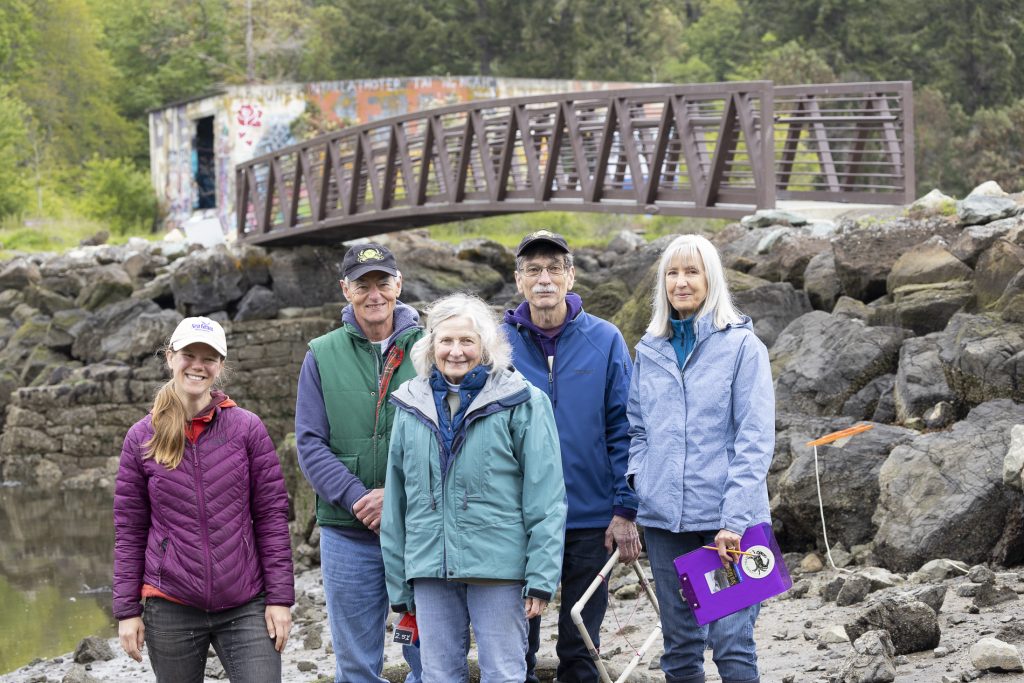
Crab Team volunteers who keep tabs on Blakely Harbor. From left to right: Amy Linhart (staff), Steve Hannuksela, Jane Hannuksela, Bob Rosenbladt, and Cath Bohlke. Not pictured: Maradel Gale and Jeri Meyer. Photo courtesy of Dorothy Rosenbladt.
Now, a valiant crew of Crab Team volunteers monitor the shorelines of this unique Crab Team site, bringing with them a wealth of knowledge and passion for local ecosystems. In addition to seamlessly leading monitoring efforts at this site, team captain Bob Rosenbladt has extensive volunteer experience at the SEA Discovery Center and with the Kitsap Beach Naturalist program and is also a talented photographer (see photos in this article for evidence!). Jane and Steve Hannuksela bring their decades of experience working in the marine field for the National Oceanic and Atmospheric Administration (NOAA) and the Navy on environmental conservation issues; Maradel Gale is a retired University of Oregon professor and a trained marine naturalist at the The Whale Museum and a beach naturalist through the Seattle Aquarium and WSU Extension Beach Naturalist program. Cathy Bohlke has a background in hydrogeology where she spent much of her career assessing and cleaning up contaminated sites. Finally, Jeri Meyer has volunteered with Crab Team since the very beginning of monitoring at Blakely Harbor in 2016 and has contributed many hours to this project. When reflecting on their favorite aspects of volunteering with Crab Team, the Blakely Harbor crew expressed appreciation for working with interesting colleagues, the opportunity to learn about native species, connecting with visitors passing by, and ultimately, they all value the opportunity to make a difference in their local community.
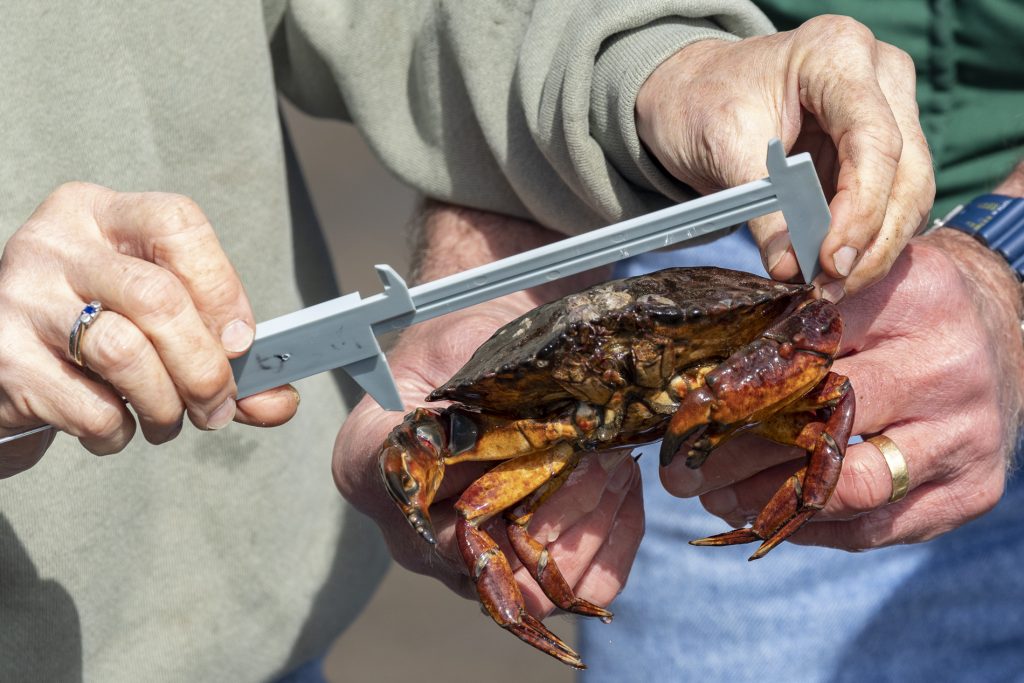
Jane and Steve Hannuksela tag team the precarious chore of measuring carapaces of large red rock crabs captured in traps. Photo courtesy of Dorothy Rosenbladt.
While monitoring at Blakely Harbor, volunteers have learned how to confidently wrangle powerful crab claws. They capture more red rock crabs than any other site in the Crab Team network, and as Maradel noted, “it’s been fascinating to see the number and way that the red rock crabs come in,” as they are often missing claws and legs. Being muddy, this site might be a less-preferred habitat type for rock crabs than for other species, and so it may serve mostly as a refuge for those rock crabs undergoing recovery. (Notably, however, that same mud might make this site more favorable for green crabs, which can tolerate more extreme conditions than large rock crabs.) Steve and Jane have developed a clever two-person system for holding and measuring these bruisers (see our video for a solo approach to handling large crabs) enabling them to safely work their way through the catch. The team suspects rock crabs are occasionally to blame for mangling minnow traps trying to get into the traps – because they can’t fit through the openings, they try to pry their way in to the tasty bait. Monitors at Blakely have also trapped many other interesting species we don’t see frequently across the network, ranging from nudibranchs to pipefish, and recently some of our first padded sculpins.
Underneath the muddy sediment that houses many of these native critters lies remnants of the historic mill, including rotting chunks of bark, milled boards, and dark sawdust, which are visible at low tide in some parts of the harbor. In particular, scientists from the Washington Department of Ecology are concerned about the decomposing wood and associated toxins that are leaching into the marine sediment. Studies show that even the upland soils contain contaminated materials. The agency has provided $150,000 to fund research aimed at assessing the true level of contamination linked to the historic sawmill operations, specifically assessing the presence of metals, phenols, polycyclic aromatic hydrocarbons and dioxins/furans that exceed safe levels. As successor to the historic Port Blakely Mill Company, the Port Blakely Company is the corporation responsible for the clean-up of the site’s substrate and is working closely with the Department of Ecology on this restoration initiative.

A side-by-side comparison of Blakely Harbor during its lumber mill heyday (left) and today’s peaceful harbor (right). Photos courtesy of the Bainbridge Island Historical Society and Bob Rosenbladt (and his drone!)
Over the past two centuries, Blakely Harbor has seen enormous changes to its local ecosystems. At this point, no European green crabs have been captured anywhere on Bainbridge Island, so we hope that this is one attribute that remains the same into the future!
–Amy B. Linhart
Citation: Price, Andrew (2005) Port Blakely: The Community Captain Renton Built. Bainbridge Island Historical Society.
Photo Gallery
We love to get the virtual experience of monitoring with all of the Crab Team volunteers. Do you have a photo to share? Send it to crabteam@uw.edu. (Click on arrows to scroll, and photos to enlarge for more detail.)
